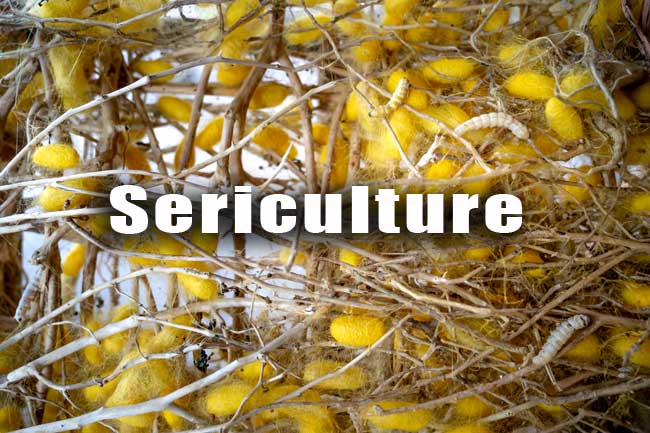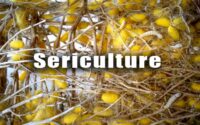Sericulture Mock Test
Applicants can download the Sericulture Mock Test Question Papers and Sericulture Exam Mock Test Papers. On this Page, we have updated Sericulture Mock Test Papers and Sericulture Books for the sake of Aspirants. Download the Sericulture Mock Test Question Papers and make as a reference for the exam preparation. The Sericulture Mock Test Papers available here in the PDF forms. Eligible & Interested candidates can download the Sericulture Mock Test Question Papers just by tapping on the direct links given below. Download the Sericulture Mock Test Papers along with Solutions.

Mock Test Questions Papers on Sericulture
1. Which country is producing all the four commercial silk in the world?
(a) India
(b) China
(c) South Korea
(d) Japan
2. Muga silk is produced only in :
(a) India
(b) Bangladesh
(c) Pakistan
(d) Myanmar
3. Define Sericulture.
(a) Sericulture is the science that deals with the production of raw silk by rearing of silkworms.
(b) Silk culture
(c) Silkworm rearing
(d) The process in which raw silk is produced
4. More than _____________ % of the raw silk production in India is mulberry silk.
(a) 80 %
(b) 87 %
(c) 89 %
(d) 77 %
5. What is ants well?
(a) It is the seat of rearing rack
(b) Alluminium bowl
(c) It is a device to prevent ants from entry into the rearing racks containing rearing tray.
(d) Plastic mug
6. The scientific name of Mulberry silkworm is :
(a) Bombyx mori
(b) Bombyx mandarina
(c) Bombyx rotundapex
(d) Bombyx incomposita
7. Philosamia ricini is the scientific name of :
(a) Eri silk worm
(b) Muga silkworm
(c) Oak Tasar silkworm
(d) Mulberry silkworm
8. Out of the four variety of silkworms which one is the only monophagus in nature.
(a) Mulberry silkworm
(b) Muga silkworm
(c) Eri silkworm
(d) Oak tasar
9. In Orissa Tropical Tasar is mainly fed on _____________ leaves.
(a) Sal
(b) Arjun
(c) Ber
(d) Janum
10. Explain polyphagus insects?
(a) Insects (including silkworm) that feed on more than one food plants.
(b) Multi food plants
(c) Muga silkworm only
(d) Mulberry silkworm only
11. Silkworm undergoes _____________ moulting.
(a) Two
(b) Three
(c) Four
(d) five
12. _____________ symptoms are intersegmental membranes of the body which becomes swollen and the skin becomes shiny.
(a) Flacherie
(b) Muscardine
(c) Grasserie
(d) Pebrine
13. What is Voltinism?
(a) Voltinism is the number of generation in a year
(b) One generation in a year
(c) Two generation in a year
(d) Number of moulting in a year
14. What is fecundity?
(a) Number of eggs laid by muga moth
(b) The number of eggs laid by a single moth
(c) Number of eggs laid by eri
(d) Number of mulberry eggs
15. The average number of eggs laid by Mulberry silk moth is :
(a) 300
(b) 400
(c) 450
(d) 500
16. Explain Chawki rearing.
(a) Rotational rearing
(b) Rearing of young age silkworm (preferably upto 2nd moult out) under optimum climatic conditions.
(c) Rearing of late worms
(d) Rearing of first stage worms
17. Explain Why Chawki rearing is necessary?
(a) To protect early age worms
(b) Chawki rearing is necessary to minimize the loss and mortality of young age worms and to increase cocoon yield
(c) To increase filament length
(d) To increase cocoon yied
18. What is the purpose of Ante room?
(a) To act as barrier to the entry of Uzi fly
(b) To act as disinfection room
(c) A room to culture Uzi fly
(d) Prevention of Uzi fly
19. Optimum temperature for rearing mulberry silkworm is :
(a) 24o C – 26o C
(b) 24o C – 25o C
(c) 26o C – 28o C
(d) 23o C – 28o C
20. What is the main physical disinfectants?
(a) cold storage
(b) sunlight
(c) wind
(d) to keep outside
| MCQs | Objective Questions |
| General Knowledge | Interview Questions |
| Quiz | Previous Papers |
| Practice Papers | Old Papers |
| Top Questions | Sample Papers |
| Mock Test | Model Question |
| Important Question |
21. What is the tropical Tasar silkworm reared in India?
(a) Anthereae roylei
(b) Anthereae mylitta
(c) Anthereae yamamai
(d) Anthereae proylei
22. Muga worms came down to the bottom after consuming the leaves, this phenomenon is called :
(a) geotropism
(b) descending worms
(c) falling worms
(d) bharpok
23. The chromosome number of Anthereae proylei is :
(a) 30 – 49
(b) 30
(c) 25 – 30
(d) 40
24. Muga silkworm has the minimum number of chromosome than all other silkworms. The chromosome of Muga silkworm is :
(a) 25
(b) 30
(c) 15
(d) 40
25. Oak Tasar silkworm is a _____________ bivoltine.
(a) Strong
(b) Pure
(c) Weak
(d) partial
26. Silkworm undergo _____________ times moulting.
(a) Two
(b) Three
(c) Four
(d) five
27. When _____________ are out of moult feeding may be resumed.
(a) 80%
(b) 90%
(c) 95%
(d) 100%
28. The biochemical aspect of A. myllita have been studied and showed pH of diseases larvae of the body fluid increase towards _____________ .
(a) Acidity
(b) Alkalinity
(c) Both acidity and alkalinity
(d) None of these
29. Hybrid vigour is also known as :
(a) Crossing of two species
(b) Heterosis
(c) Dominant gene
(d) Crossing of two breeds
30. Under major classification of insects, Mulberry silkworm comes under the family of :
(a) Bombycidae
(b) Saturniideae
(c) Lepidoptera
(d) Monoclamydae
31. Anthereae pernyi feeds on _____________ leaves.
(a) Oak
(b) Castor
(c) Som
(d) Soalu
32. What is cross breed?
(a) Crossing of two different races
(b) Cross breed is the mating of two or more different breeds
(c) Crossing of two breeds
(d) Production of Multi x Bi
33. Where a univoltine race is reared in India?
(a) Bihar
(b) Kashmir state
(c) Karnataka
(d) West Bengal
34. How many types of mutation breeding are there?
(a) Two
(b) Three
(c) Four
(d) Five
35. Define generation gap?
(a) The time between the parents and the offspring
(b) The average age of the parents when their offspring are born
(c) The gap between the moth and the silkworms
(d) The life cycle of an insect
36. Most absorption of water in a plants takes place from the :
(a) root tap
(b) root branches
(c) hairs zone
(d) tape root
37. The arrangement of leaves in a plants is known as :
(a) leaf bud
(b) attachment of leaf
(c) phyllotaxy
(d) taxonomy
38. Male and female moth of Tasar silkworm can easily be differentiate from the :
(a) Wings
(b) Thorax
(c) Antennae
(d) abdomen
39. The abdomen of female moth in mulberry is comparatively _____________ than the male moth
(a) Smaller
(b) Bigger
(c) Longer
(d) thinner
40. The scientific name of Muga silkworm is :
(a) Antherea mylitta
(b) Antherea assamensis
(c) Antherea polyphemus
(d) Antherea frithi
41. Phylosamia Cynthia is the wild silk moth of :
(a) Muga
(b) Tasar
(c) Eri
(d) Mulberry
42. Leaf rust is caused by :
(a) Virus
(b) Leaf gall
(c) Fungus
(d) Bacteria
43. Powdery mildew is a fungus caused by :
(a) Phyllactinia corylea
(b) Cercospora moricola
(c) Cerolellum fici
(d) Puccinia triticina
44. The leaf spot of som can be controlled by spraying :
(a) Bavistin
(b) Indofil M-45
(c) Mathene M-45
(d) Glycel
45. The causative agent of Pebrine disease is :
(a) Berrelina virus
(b) Nosema bombysis
(c) Polyhedrosis
(d) Puccinia recondita
46. Name the disease of silkworm that can be transmitted from parents to the offspring.
(a) Virus disease
(b) Fungal disease
(c) Bacterial disease
(d) Pebrine disease
47. The most common disinfectant used in silkworm rearing is :
(a) 2 -5% formalin
(b) 0.1% rogor
(c) Bleaching powder
(d) Lime
48. The most economic method of silkworm rearing is :
(a) tray rearing
(b) shoot rearing
(c) chawki rearing
(d) by any means
49. The mode of transmission of disease from the infected mother moth is called :
(a) transfer of disease from the ovary
(b) transovarial
(c) inherited disease
(d) transgenesis
50. Plant hopper is also called :
(a) leaf hopper
(b) root knot
(c) jassid
(d) sucking insect

